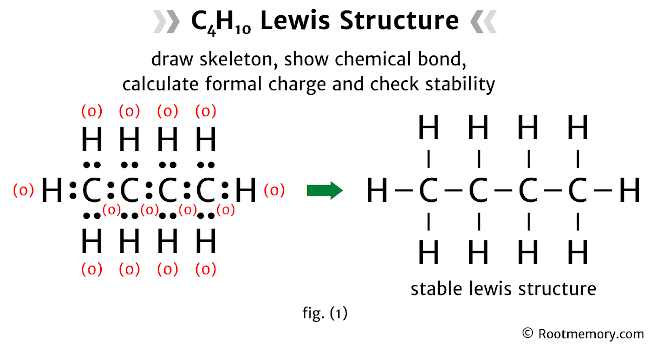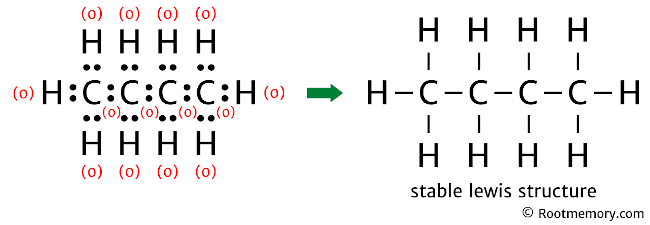
The Lewis structure of C4H10 contains thirteen single bonds, with four carbons in the center. The left carbon and right carbon are attached with three hydrogens, and two center carbons are attached with two hydrogens. Both hydrogen atom and carbon atom do not have any lone pair.
Steps
By using the following steps, you can easily draw the Lewis structure of C4H10.
#1 Draw skeleton
#2 Show chemical bond
#3 Calculate formal charge and check stability (if there are no lone pairs and octet is already completed on central atom)
Let’s one by one discuss each step in detail.
#1 Draw skeleton
In this step, first calculate the total number of valence electrons. And then, decide the central atom.
- Let’s calculate the total number of valence electrons
We know that… carbon is a group 14 element and hydrogen is a group 1 element. Hence, carbon has four valence electrons and hydrogen has one valence electron.
Now C4H10 has four carbon atoms and ten hydrogen atoms.
So the total number of valence electrons = (valence electrons of carbon atom × 4) + (valence electrons of hydrogen atom × 10)
Therefore, the total number of valence electrons = 16 + 10 = 26
- Now decide the central atom
We can not assume hydrogen as the central atom, because the central atom is bonded with at least two other atoms. And hydrogen has only one electron in its last shell, so it can not make more than one bond.
Therefore, choose carbon as the central atom.
But there are four carbon atoms in C4H10. Hence, we can assume any one as the central atom. Let’s assume that left carbon is the central atom.
So now, put four carbons in the center and ten hydrogens on either side. And draw the rough skeleton structure for the Lewis structure of C4H10 something like this:

Also read: How to draw ClO2 Lewis structure (6 steps)
#2 Show chemical bond
Place two electrons between the atoms to show a chemical bond. Since four carbons are surrounded by ten hydrogens, use twenty-six electrons to show thirteen chemical bonds as follows:

In the above structure, you can see that the octet is completed on the central atom (left carbon), and also on the outside atoms. Therefore, the octet rule is satisfied.
After completing the octet, one last thing we need to do is, calculate the formal charge and check the stability of the above structure.
Also read: How to draw Lewis structure of SCl4 (4 steps)
#3 Calculate formal charge and check stability
The following formula is used to calculate the formal charges on atoms:
Formal charge = valence electrons – nonbonding electrons – ½ bonding electrons
Collect the data from the above structure and then, write it down below as follows:
- For each carbon atom
Valence electrons = 4
Nonbonding electrons = 0
Bonding electrons = 8
Formal charge = 4 – 0 – ½ (8) = 0
- For each hydrogen atom
Valence electrons = 1
Nonbonding electrons = 0
Bonding electrons = 2
Formal charge = 1 – 0 – ½ (2) = 0
Mention the formal charges of atoms on the structure. So the Lewis structure of C4H10 looks something like this:

In the above structure, you can see that the formal charges of both (carbon and hydrogen) are zero. Therefore, this is the stable Lewis structure of C4H10.
And each horizontal line drawn in the above structure represents a pair of bonding valence electrons.
Related
- ClO2 Lewis structure
- Lewis structure of SCl4
- Lewis structure of SeO3
- Lewis structure of H2SO3
- Lewis structure of CCl2F2
External links
- Chemical Bonding: C4H10 Lewis Structure – The Geoexchange
- C4H10 (Butane) Lewis Structure in 6 Steps (With Images) – Pediabay
- C4H10 Lewis structure, Molecular geometry, Polar or nonpolar, Hybridization – Topblogtenz
- What is the Lewis structure of C4H10? – Homework.Study.com
- Draw two lewis structures for a compound with the formula c4h10 – Brainly
- Draw Lewis structures for two compounds of formula C4H10 – Chegg
- How is the dot structure of C4H10 (butane) determined? – Quora
- draw two lewis structure for a compound with the formula C4H10 – OneClass
- Draw Lewis structures of C4H10 – Quizlet
Deep
Rootmemory.com was founded by Deep Rana, who is a mechanical engineer by profession and a blogger by passion. He has a good conceptual knowledge on different educational topics and he provides the same on this website. He loves to learn something new everyday and believes that the best utilization of free time is developing a new skill.
